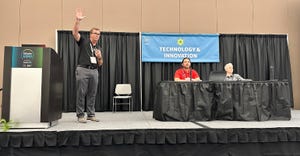recycling: New Opportunities For State Landfill Diversion
January 1, 1997
Dana Leisten
Recent legislation in California has overturned the state's Superior Court ruling that alternative daily covers (ADC) using green wastes do not qualify as landfill diversion.
Since the state established its 50 percent diversion mandate in 1989, local jurisdictions have had to develop comprehensive reduction, reuse and recycling programs. Local facilities failing to meet these goals by the year 2000 will be subject to financial penalty by the state.
Originally, the mandate was intended to extend the life of solid waste landfills through waste reduction, reuse and recycling. However, using green materials (grass clipping, twigs and leaves) for ADC was not specifically defined as recycling in the bill. As a result, the state's Supreme Court, in the case of Natural Resources Defense Council vs. California Integrated Waste Management Board (CIWMB), denied cities and counties diversion credit for green wastes ADC, as well as other landfill recycling activities.
Now, with the implementation of Assembly Member Cruz M. Busta-mante's AB 1647, significant obstacles to reaching diversion goals in municipalities have been removed, according to the Coalition Organized for Viable Environmental Recycling (COVER), a California-based organization that includes cities, counties, municipalities and private haulers. With the new bill in place:
* CIWMB policies governing solid waste diversion will be consistent with the California Public Resources Code;
* landfill capacity will continue to be extended;
* local jurisdictions will have more freedom to establish the kind of waste diversion programs that work best in their individual areas;
* the use of green wastes ADC will be a qualified waste reduction alternative;
* landfill participation in recycling programs will in-crease by allowing on-site recycling activities to be eligible for solid waste diversion credit; and
* green material recycling will be encouraged in municipalities by "jump starting" green waste collection programs.
Conservatively, the cost of processing green material for ADC versus compost is approximately $5 per ton, compared to $20 per ton, respectively. If local jurisdictions were not able to use green material ADC for diversion credit, ratepayers and taxpayers would pay millions of dollars more per year to recycle, according to CIWMB. Furthermore, cities and counties also would incur significant costs for developing new diversion programs that excluded ADC.
Critics are concerned that implementation of this bill would reduce the progress made in other areas of green waste recycling. However, ac-cording to CIWMB, green material will continue to be used extensively in composting. In fact, figures show that the ratio of green material used for composting versus ADC is eight-to- one (see chart). Only 500,000 tons of green material are used annually as ADC, while more than 4 million tons are composted. Further, statistics show that, since 1990, there has been a 576 percent increase in composting activity.
Another motivating factor behind AB 1647 is that with more than 22 million tons of compostable material produced annually in California, the existing composting market cannot meet that processing output. If this material is not composted, used at a biomass facility or as an ADC, it is landfilled. Currently, more than 8.5 million tons of compostable materials still are being disposed annually.
For more information, contact: Jessica Reynolds, 555 Capital Mall, Ste. 600, Sacramento, Calif. 95814. (916) 446-6667. Fax: (916) 446-0674.
You May Also Like


